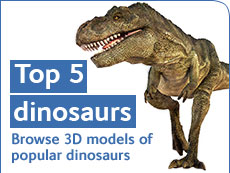Ostrich dinosaurs
Paul Barrett

The skeleton of the omnivorous dinosaur, Gallimimus.
Ostrich dinosaurs (scientific name: ornithomimosaurs) appeared on Earth during the Lower Cretaceous Period, around 125 million years ago. However, they were most successful during the last few million years of the Cretaceous (and therefore of the dinosaurs), when they lived in large numbers in what is now eastern Asia and western North America.
All members of this group bear a striking resemblance to some of the large flightless birds that are alive today, such as ostriches and emus. Ornithomimosaurs, like ostriches, had long graceful necks, small heads with a beak-like snout, very long legs (which allowed them to run at up to 60 km per hour) and a slender tail. They were members of the dinosaur group Theropoda, which also includes Tyrannosaurus, Velociraptor and the 'dino-birds'.
What did they eat?
Most theropods were meat-eaters and were equipped with a fearsome set of curved, sharp teeth with serrated edges, which could be used to slice through flesh. However, the majority of ornithomimosaurs differ from most other theropods in one important way – they have no teeth .
This presents a problem for palaeontologists, as they generally use information on tooth shape to deduce the diet of extinct animals. In the case of ornithomimosaurs other dietary clues have to be found. All sorts of diets have been suggested – some palaeontologists have proposed that ostrich dinosaurs were mostly carnivorous, maybe eating small animals, such as lizards or large insects, which could be swallowed whole without the need for teeth. Others suggest that they could filter-feed, rather like giant flamingos, using their beaks as sieves, while another theory argued that these animals ate plants, fruits and soft leaves that did not need to be chewed.I decided to look again at the evidence for ornithomimosaur diet, to see if it was possible to decide between all of these alternatives.
The evidence
The hands and feet
The skeleton of an ornithomimosaur has no obvious features that would suggest it was a meat-eater . In particular, the hands are not suitable for grasping struggling prey and the feet lack the large claws that some other theropods use as weapons during hunting.
The beak and gastroliths
However, the skeleton does provide some clues to suggest that ornithomimosaurs were plant-eaters. Ostrich dinosaurs are known to have possessed beaks , similar to those of turtles and tortoises, which have a series of long narrow ridges and grooves on the inside of the beak that help to slice plant material.
Stomach stones
These beaks are solidly built and lack the fine sieve-like structures seen in flamingos, so ornithomimosaurs probably did not use their beaks to dabble for water plants and animals. Stomach stones (gastroliths) are also present in some ornithomimosaurs. These are found only in plant-eaters among land-living animals, and are used to grind up tough plant food in the stomach.
How common were they?
Some evidence also suggests that these animals may have had a vegetarian diet. For example, today’s carnivores need large numbers of herbivores to support them, so it is a general ecological rule that herbivores are much more abundant than the carnivores preying upon them. The same rule was also true back in the Cretaceous. Ornithomimosaurs appear to be much more common in the fossil record than they should have been if they were carnivorous: this is more evidence that these animals were probably herbivores.
More questions...
The vegetarian diet of ornithomimosaur is highly unusual among theropods and raises a number of interesting questions, which have yet to be answered. Are any other theropod groups herbivorous? Why should only a few theropods evolve to eat plants, given that other groups of plant-eating dinosaurs, such as sauropods, were so successful?
Here and in Museum's and universities around the world, Palaeontologists will are now looking to answer these questions.
Toolbox
Read more about Dippy

Go on an engaging tale of discovery in Dippy, a book published by the Museum.
Discover the famous cast, its history and importance and read about one of the longest land animals ever to walk the Earth.
